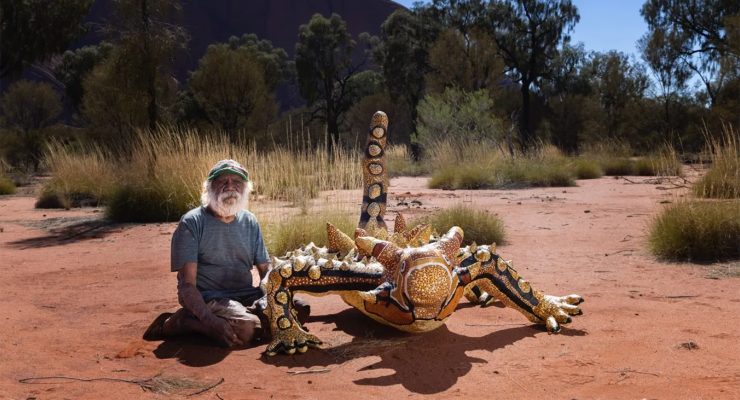
Carloads of central Australian artists rolled into Mparntwe (Alice Springs) last week for the opening of the annual Desert Mob art festival.
The exhibition of 350 artworks by 250 Indigenous artists at Araluen Arts Centre was smooth-running, slick and sophisticated, but as art centre managers and curators told Crikey on opening night, the logistics of getting artworks and artists into town was anything but.
“He’s made his way up here on the back of a ute wrapped in sheets and bubble wrap,” manager of Walkatjara Art Nancy Green said of a 1.6-metre, 30-kilogram sculpture of a thorny devil (Ngiyari in Pitjantjatjara).
“He went straight up the Stuart Highway with his tail in the air. Which is exactly what they look like on the road.”

Green said the logistics of transporting an artwork of this size and weight was not on the agenda until after it was finished: “We created it without measuring it, so we had no idea what we were in for. It was just like, ‘Let’s create it and then let’s work out how it’s going to get to Alice Springs.’ ”
Walkatjara Art is one of 35 Central Australian community art centres contributing works to this year’s 32nd edition of Desart’s Desert Mob. Spanning an area of 1.221 million kilometres and 16 language groups, many travelled big distances and many hours to deliver their artworks to deadline and artists to the exhibition opening. Flat tires and car breakdowns were stock standard as drivers contended with dust, dirt, divots and fire.
“There’s every conceivable way possible for them to arrive here,” co-curator of the exhibition Arrernte and Kalkadoon woman Hetti Perkins told Crikey. “It’s not really something you want to hear about in advance — that it’s been sitting in the back of a ute or curled up on the top of a troopy. But when we say, ‘Will you arrange for the freight?’ They say, ‘Yes, we’ll arrange for it.’ And they do.”
Perkins explained that curating an exhibition like this was “less curating in a classic sense and more coordinating and collaborating”, with the selection of works largely under the jurisdiction of art centres. The biggest challenge for her was ensuring things arrived on time and in one piece.
“There’s a process that a lot of art centres are able to meet, but also people get in touch with us and say, ‘This has happened, that’s happened,’ ” Perkins said.
“Sometimes it’s a bit of a scramble at the end, but we understand there are a lot of pressures on art centres and we don’t want to be part of that problem. We know things happen out bush, but the most important thing is to hear the artist’s voice. Desert Mob is all about the artist’s voice.”
Manager of Warlayirti Artists Poppy Lever said Desert Mob — a “positive event” for artists, family and mob desert-wide to come together — was a “tiny 5% blip” in the grand scheme of work done by art centres out bush. The “smooth and streamlined” finished product of art exhibited in a clean white space was, she said, in stark contrast to the “madness” of a standard day in an art centre office — with more time spent tracking down artists than in the studio.
“It’s not like everyone’s sitting there saying, ‘I can’t wait to do my Desert Mob piece of artwork.’ It’s very much who’s operating, who have we got, who’s in community and how can we get that person from six hours away back into community so they can finish this piece that we really want to submit,” Lever said, recounting the mad rush a few years back to get a particular artist’s work to Alice Springs by deadline.
Lever said it took weeks and weeks of chasing down the artist to finally get her into the art centre (the day before deadline) to finish the piece.
“She stayed behind until eight o’clock that night. And I remember her friend sat with her. She said to me, ‘I’m missing Home and Away for this,’ ” Lever said.
“When the final dot happened, I packed it and drove 12 hours down a bumpy road the next day to get it in on time. It just takes this insane, convoluted toing and froing to get something like this to happen.”
Crikey heard stories from art centre managers right across Central Australia with a transportation remit to “simply make it work”. Manager of Nyinkka Nyunyu Art and Culture Centre Lévi McLean said his artists’ work landed in an “impromptu sculpture garden” for three months because they were too big for the nominated indoor storage space at Araluen Arts. The three barrels — repurposed oil drums from a derelict mine near Tennant Creek — measured close to four and a half metres.
“There was no space to keep those sculptures here, so I had to improvise,” McLean said.
Many of the pieces displayed at Desert Mob are valued in the thousands of dollars, with the most expensive artwork on sale for $65,000. Given the calibre and medium of work (not confined to canvas), McLean said a packaging and transfer service beyond makeshift blankets and bubble wrap would not go astray: “It’s a Hail Mary to get a sculpture 1000 kilometres from A to B in one piece.”








Flat “tires”??? In a story about navigating the Australian outback, using American spelling is incongruous.
Thank you for all these interesting, informative and cheerful reports.